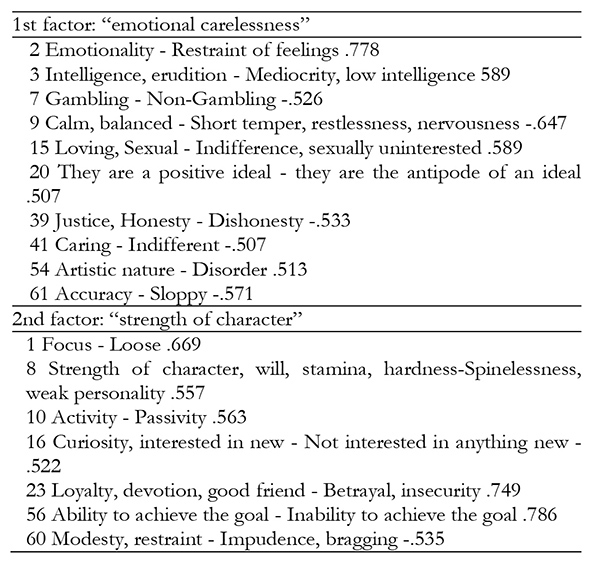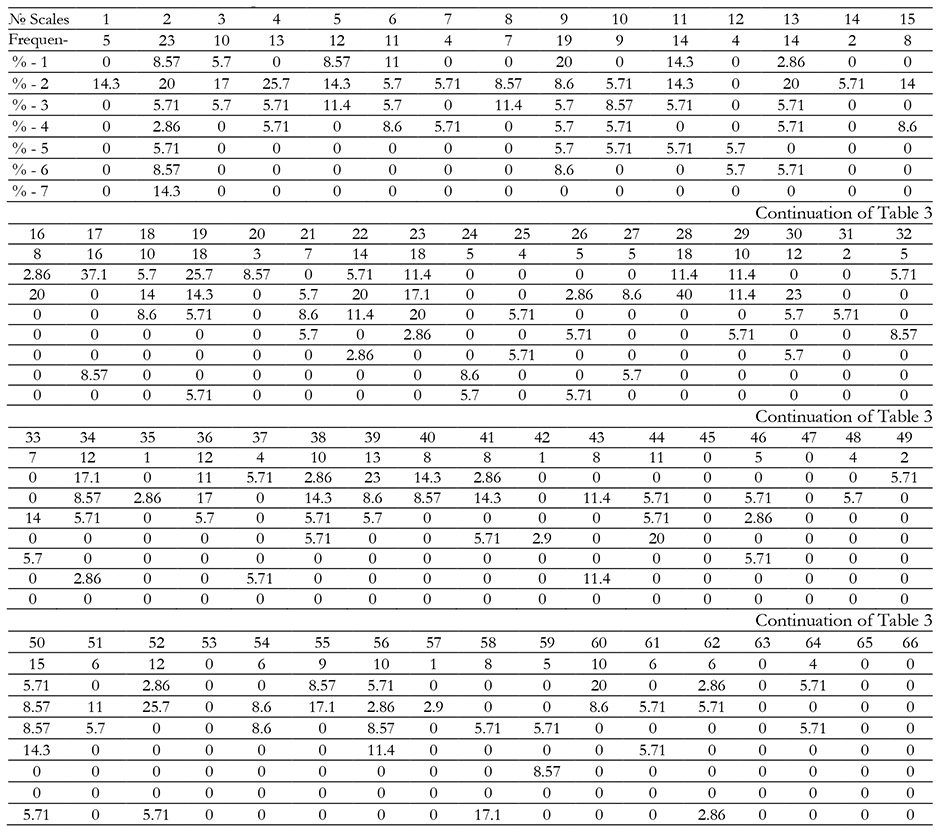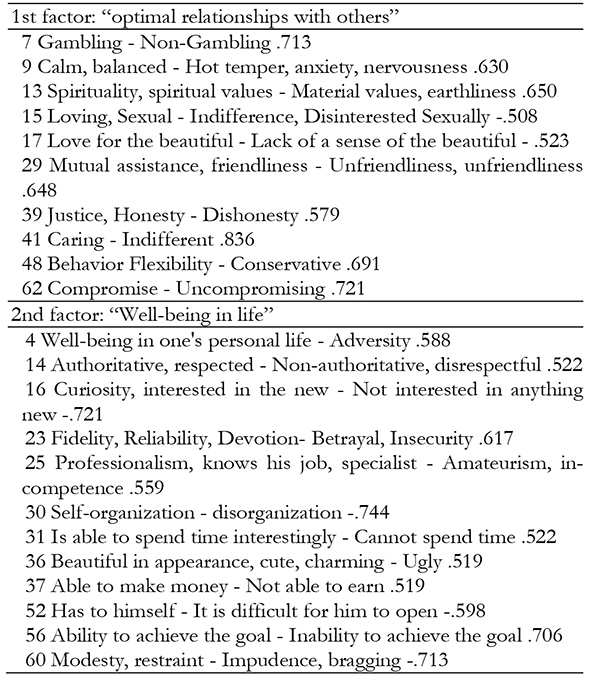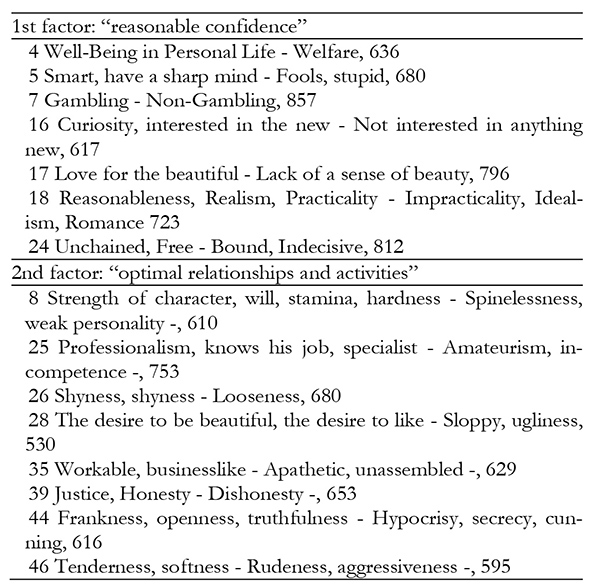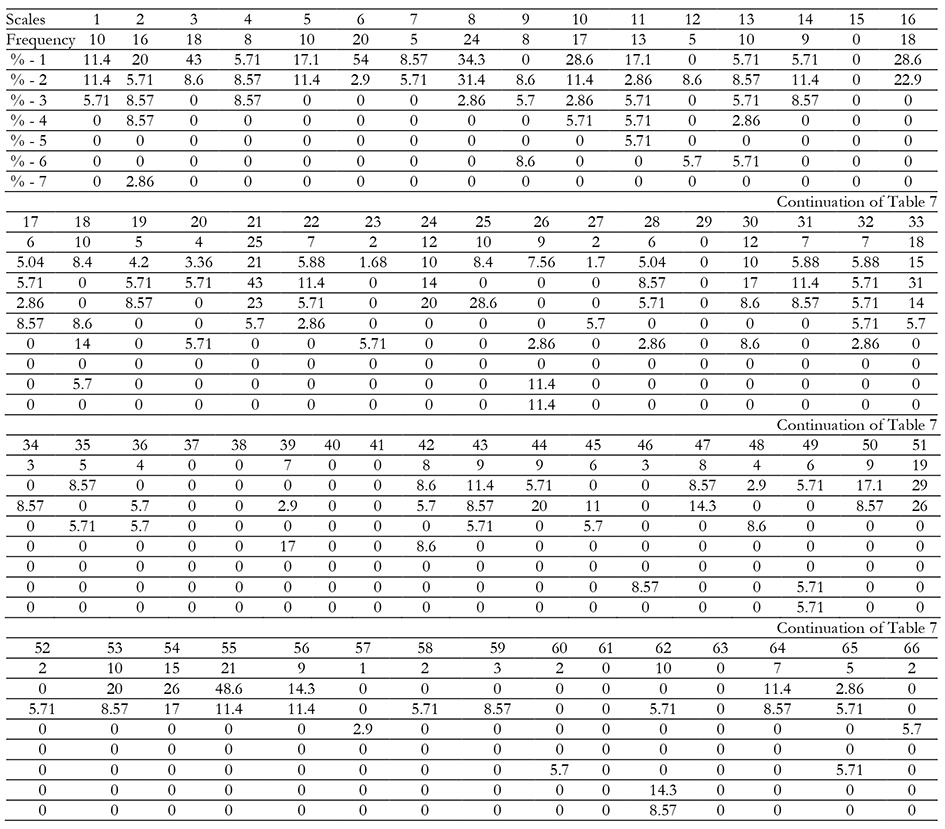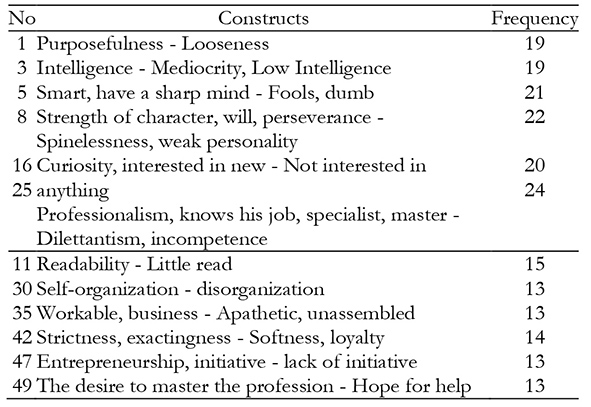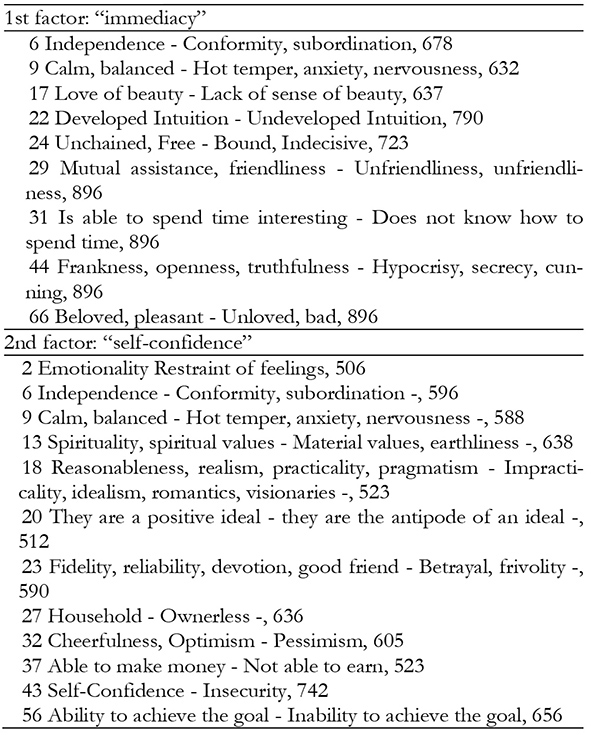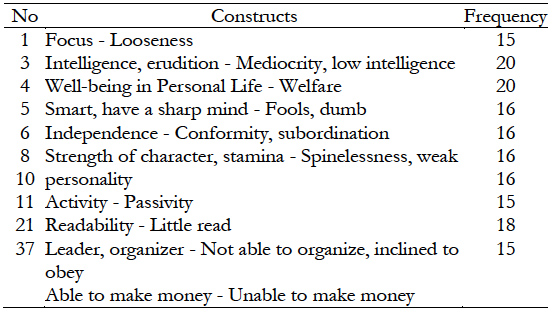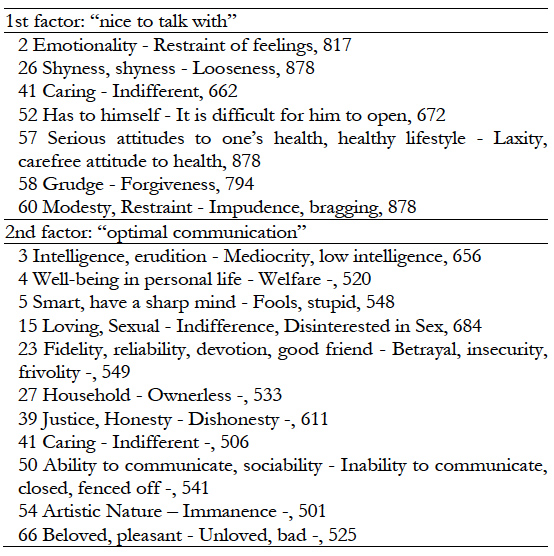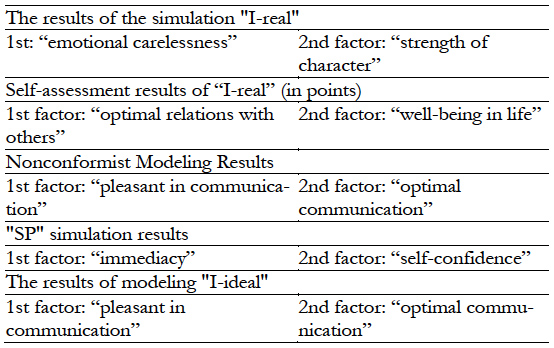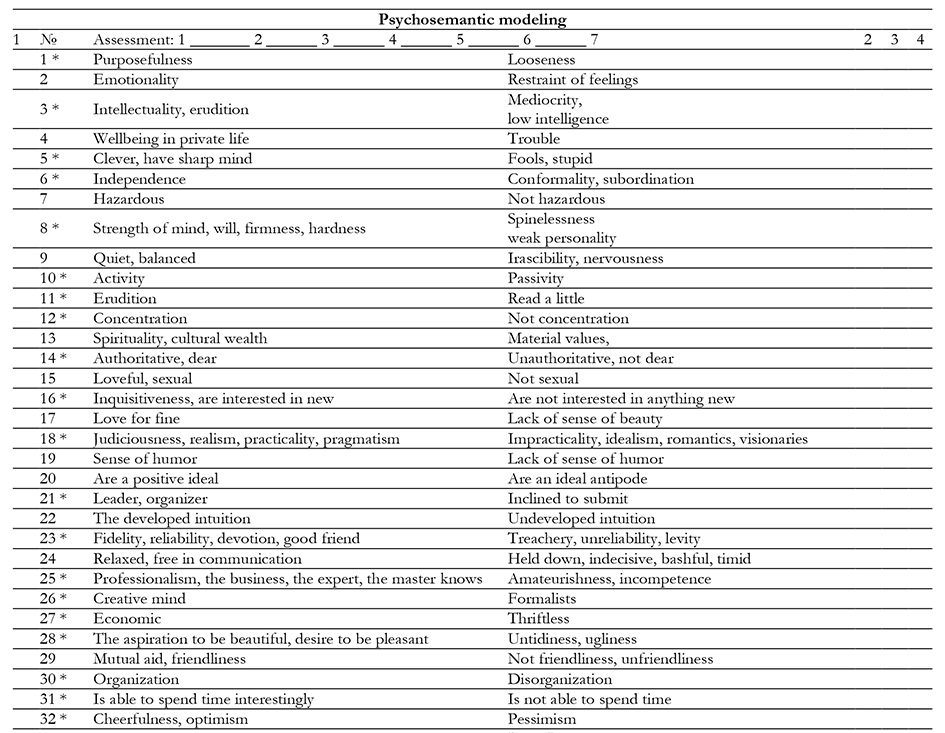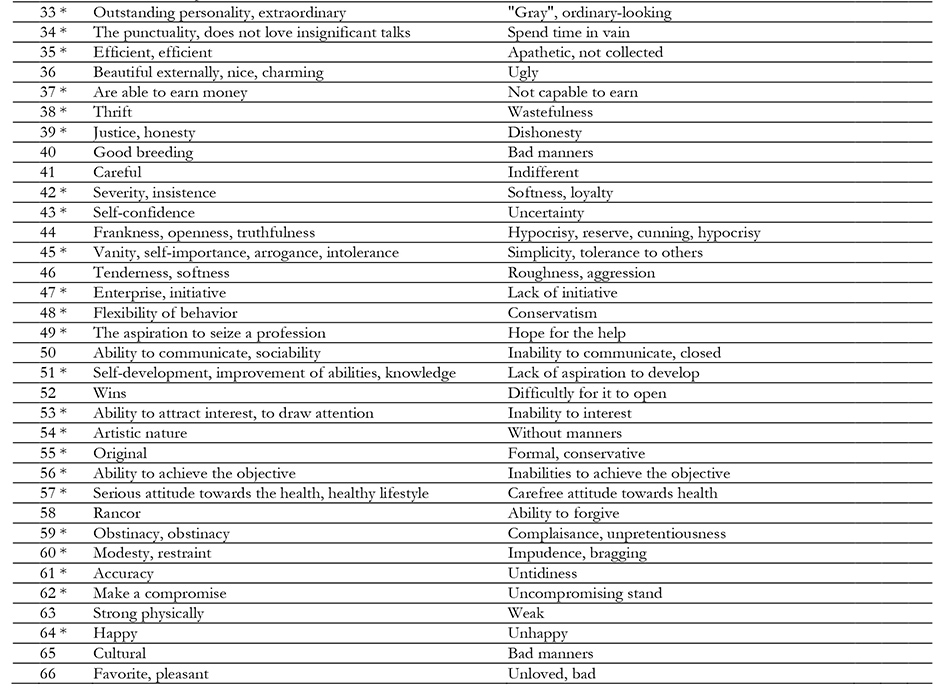Introduction
Now, in psychological science, increasing number of researchers of a focused on studying the subject sphere of the personality in aspect of self-organization of behavior and lives activity, in that number and social relations (Brushlinsky, 2002; Dyakov, 2016 a-c; Sergienko, 2003; Tatenko, 1996). Concept of the subject to an researchers connect with properties of self-motivated activity (Ryan et al, 2017), independence (Tatenko, 1996), self-determination (Whittingham, 2018), free will (Koestern et al, 2014) and creativity, and reflect in such types of the personality as the nonconformist, the self-updated personality etc. (Dyakov, 2016c). These characteristics and types disclose the modern post-nonclassical, phenomenological, existential and humanistic principles of understanding of the person in psychology and philosophies. The problem of self-updating is in whether the person as the subject is capable to make the choice, to make the decision and to form intention to overcome external difficulties and internal weakness (impulsiveness, reactivity, uneasiness) that creates conformality and indecision (Whittingham, 2018). Considering that the person lives in the typical environment, constancy of conditions of his life defines typicality of experience adaptation and sociocultural identification (Fogelson, 1982), and from here, typicality of a way of life and properties of the personality. Thus, the person as the personality self-organizes in process of the knowledge and determination of values and meanings of "things" in field of life. From here personality as subject in the mental information-semantic (cognitive and intellectual (understanding sociocultural values of things and life phenomena) and axiological (value-semantic orientations)) of self-organization focused by certain sociocultural standards and norms.
Subject's paradigm and subjectness in psychology touches on an issue of a system understanding self-organization ontology and self-development "live" twisting in intentional continuum lives (Dyakov, 2016с). This problem is widely reflected in to philosophy and science. The self-organization, category synthesized in synergetic is considered in aspect of transdisciplinary integration in development of complex intellectual systems today (Heylighen, 2011), where the subject loses the anthropological value (Whitehead et al, 2012). The cyberspace washes away identity and distinctions, forcing to rethink a concept of the subject (Whitehead et al, 2012). Nevertheless, we still are interested in aspects of the relation of the person to the world and life, its semantic structures in which foreshortening it as the subject defines the activity. It is no secret that it is connected with speech functions in a conceptual categorization of semantic constructs of conscious structuring and conceptualization of experience. Self-organization is considered in psychological systems in aspect of a meaning formation (Klochko, 2005).
Development of modern cognitive psychology and neuroscience updates a research of human language and the speech as highest achievements of the nature therefore the intelligence and consciousness developed. Researchers consider language as a self-organizing cognitive system which then materializes a thought in words (Clark, 2013). Actually, the brain is a predictive system (Bar, 2007; Barrett, 2009; Clark, 2013), which is under construction on the basis of individual experience in aspect of systematization of values in creation of semantic structure of life (Fodor). These aspects define the prospect of development of psychological science revealing in psychosemantics (Artemyeva, 1999; Fodor, 1987). Also, in researches the neuro and cognitive models opening are considered: communication of neuroscience with psychology (Levine, 2018); narrative representations of experience as generative models in hierarchical predictive data processing (Farmer et al, 2013; Hirsh et al, 2013). Interests scientists as culture in autobiographical (semantic) memory of the person is displayed (Wang et al, 2011) and also forecasting models in the system of scientific knowledge (Pirozhkova, 2018). These aspects of modeling of personal linguistic-semantic structures of sociocultural identification are relevant for our research. The modern psychology focused on the modeling paradigm (Bandura, 2017). It is relevant in aspect of understanding of a system of values in a categorization of structure of individual experience of the subject (Richardson et al, 2014). At the same time, progressive technologies in the field of informatics and cybernetics demand special researches of syntactic generative modeling of dependence in linguistic structure "predicate argument" (Clark, 2013; Hockenmaier, 2003). Also, the problem of digitalization of society requires the solution (Karakozov et al, 2019), which is connected with modeling of strategies of development for the personality and group including in educational space.
Today it is accepted to understand information the universal generator of self-organization of reality (Podoprigora, 2016). Basic researches in fields of physics and prove to cosmology that semantics Integra istivny, universal principle systemic organization of the world and lives: D. Baume (Bom, 2010), L.V. Leskov (Groves, 2008), V.V. Nalimov - semantic space of the Universe; V.I. Vernadsky - a noosphere. So it finds reflection in psychology: сеmantic field of A. Menegetti; semantic theory of thinking of O.K. Tikhomirov; semantic models of individual mentality (neocognitive psychology) V.D. Shadrikova (Shadrikov, 2017); A.Yu. Agafonov is a person as semantic model of the world. On a row with it is developed anthropological myth-сеmantic (K. Levi-Stros and other), etc. This universality defines relevance of semantic approach in psychology of subjectness of the personality.
We consider semantics in psychology in a broad sense as a kernel of cognitive psychology (which unites psychology in information aspect of experience) (Dyakov, 2016c) that defines information and semantic criterion of mental self-organization (MSO) by means of which the categorization-conceptualization of systems of values and the semantic relations in self-organization of activity of the personality as the subject is carried out (Ch. Osgud, J. Kelly (Kelly, 1955), etc.). Domestic psychosemantics (V.F. Petrenko, etc.) models verbal categorial properties of consciousness. However, "at the position clearness of a problem of its constructive solution it is not proposed yet" (Artemyeva, 1999, 10). We develop semantic models and technology of research MSO of the subject (Dyakov, 2019, 2016 and - c) in a perspective of modern synergy approach. The person is considered in the vital field as an open circuit which self-organizes in interaction with other systems of the world and knowledge. MSO of the person develops on the basis of intentional-biological, socially-archetypic and cultural and historical semantic structures and mechanisms in space of personal experience of knowledge and understanding of values and the meaning of things and the ideas in the field of the public relations therefore it opens and realizes itself as subject of life (Dyakov, 2016c). According to J. Kelly's thesis (Kelly, 1955), each person is a researcher. Experience of the person is based on direct elements of "sensual fabric" and is categorized in semantic verbal constructs and concepts (cause and effect logical or irrational patterns) which open algorithms and structure of understanding and judgment of people by it, things and the ideas of life. The personal semantic model of the world and itself in it and also meaning of life and self-realization - is its MSO own cognitive and motivational and value model. In verbal representation of experience of life, categorization and conceptualization of knowledge of experience, the subject seeks for the independent choice from variety of properties and qualities of things and the ideas of personally significant characteristics and their interpretation, building the system of understanding of the ideas and things according to their properties and value (semantics of feelings and thoughts in MSO). These characteristics act in his consciousness as the system of concepts by means of which he can characterize himself as the personality and to explain conceptually. "Consciousness displays itself in a word as the sun in a small drop of water. The intelligent word is a microcosm of human consciousness" (Vygotsky, 1934: 318)). In turn the relations form the complete system of individual, selective, conscious communications of the personality with various parties of reality (V.N. Myasishchev, etc.). Therefore, the research of subjectness of the personality best of all gives in to study in linguistic (R. Kettel, G. Olport, etc.) and semantic (E.Yu. Artemyeva (1999), J. Kelly (Ke11u, 1955), Ch. Osgood, V.F. Petrenko, V.P. Serkin (2016), etc.) a methodological paradigm.
It is considered to be that (A. Maslow, etc.) and deep, natural (Aristotle, K. Goldstein, K. Rogers, etc.) need (motive, sense) of the person self-updating is topmost. It is process and result which reflects how the subject builds MSO and updates the motives values at different stages of a course of life (feature of semantic constructs and concepts (the values and meanings issued in thoughts and feelings)). In it the hypothesis of a research of rather youthful age consists.
In respect of development of semantic technology of a research of subjectness we offered a number of models and techniques (Dyakov, 2019, 2016a-c). The research objective - to define semantic constructs self-updating in modeling of personal identification.
Methods and techniques of a research
The sample was made by students of 3-5 courses of Sevastopol and Yalta, Russian Federation (218 people, 17-21 years.). The original experimental technique "Semantic Modelling of Self-organization of the Personality" ("SMSOP") is developed. Forms of a technique of "SMSL" are offered examinees (Dyakov, 2016c). At the heart of a technique semantic differential of Ch. Osgud. "SMSL" includes 66 dichotomizing scales constructs. This set of scales of linguistic constructs of MSO of the personality in space of sociocultural identification is received as a result of an empirical research, by means of the equipment of "repertoire lattices" of J. Kelly (see appendix 1; (N> 1000, age of 16-55 years. a psychometrics in works (Dyakov, 2016a, c)). Constructs the reflecting subject qualities are marked with an asterisk - them 43, 23 constructs background. The equipment of a self-assessment by comparison "images I am" ("I am-real" and "I am-ideal" (K. Rodgers, etc.) and also modeling of images of "The Self-updated Personality" (SUP) and "Nonconformist" (NC) in aspect of subjectness is used. A set of constructs of "SMSL" can be built on concrete sample.
The SMSL procedure (the form - Appendix 1). Instruction. in the table the scales of semantic constructs disclosing personal characteristics are given. Polar scales, have the opposite sides. You need to perform the following tasks.
See all presented constructs, and note in the 1st column "tick" from them 20. It the qualities which are most expressed at you. Designate the 1st column "I am-real". Range noted 20 constructs. A rank of the 1st - the highest. Further estimate yourself "I am-real" on the ranged constructs, according to the scale shown above, from 1 to 7 points. Quality in a construct at the left in points from 1 to 3, on the right - from 5 to 7. 4 balls are average assessment. For example, "focus looseness": a rank 1, through fraction assessment 2 = 1/2, i.e. you purposeful.
Simulate, using 66 constructs, type of the personality "nonconformist" (NC) again (the concept of the NC is defined in the form). Again allocate 20 main constructs which, are peculiar to the NC, and in column 2 range and estimate. Please, cover with a paper strip the previous column not to be guided by your results.
Simulate, using 20 constructs from 66 scales "the self-updated personality" (SUP) (the concept of SUP is defined in the form). In the 3rd column range and make assessment. Please, cover the previous results.
Again, estimate yourself in aspect "I am-ideal" what you want to become. Allocate 20 constructs from 66 scales. In the 4th column range and make assessment. Please, cover the previous results.
The procedure of the choice of 20 qualities in each task, and then ranging of on them and estimations in points is necessary for allocation of constructs, semantic relevant for the personality. Technology of definition of repertoire constructs is also presented to J. Kelli (it is also possible to range constructs (Dyakov, 2016a, c)). It was important to us to receive subjectness constructs in self-updating of the personality. This matrix of constructs allows to build semantic modeling of different types of subjectness of the personality (tolerant, inclined to risk, the ideal psychologist, etc.) and in different ways (for example, to estimate itself in points on all constructs and to compare results of the offered scales: «I am-ideal», etc.) with the subsequent factorization. The presented model defines a possibility of empirical check.
The descriptive statistics and factor analysis were applied to processing of results of a research (a method main a component, a rotation method varimax with Kaiser normalization). The statistical SPSS v 21 package is used.
Presented in Appendix 1 formulations of poles of constructs are original, i.e. are received from results of filling of repertoire lattices of J. Kelli therefore cannot always look antonymous ("artistic nature - without manners", "creative mind - formalists"). However, the value of quality of the personality is defined easily what the expert procedure semantic estimates of data confirms.
In difference from "Big five" "Hexaco" received models of the personality, etc. in our researches the constructs were not factorized mathematically as qualities of the personality, and classified by MSO properties (Dyakov, 2016a, c).
Results and their discussion
By results of ranging of constructs "I am-real." (task 1) the following data of frequency analysis (tab. 1) are obtained.
These indicators (the choice of scales "Emotionality- Restraint of feelings" (66% referred it to the first 10 ranks), "quiet, balanced - irascibility, nervousness", "sense of humor -lack of sense of humor", "fidelity, devotion, the good friend - treachery, unreliability", "the aspiration to be beautiful - untidiness", "love to fine - lack of sense of beauty") speak about emphasis in semantic aspect of these respondents, in a self-assessment of an image "I am-real", the chosen semantic characteristics of the personality. Priority value the construct got "the aspiration to be beautiful - untidiness" where the maximum rank was noted by 20% of respondents. Also maximum rank met at constructs "Emotionality - Restraint of feelings", "Happy - unhappy" and to a lesser extent for constructs "Quiet, balanced - Irascibility, nervousness", "Artistic nature - Without manners", "Modesty, restraint - Impudence, bragging", "The intellectuality, erudition - Mediocrity", "Erudition - read A little", "Cultural wealth - Material values, prosaicness", "Beautiful externally, nice - Ugly", "Justice, honesty - Dishonesty". Youth aspects of intellectuality (mind), beauty and morality (honesty, justice, fidelity) and also happiness as full satisfaction with life interest. These aspects; intellectual, esthetic and moral were defined by us in other researches and are defined as aspects of motivation and feelings of the personality, and happiness and spirituality (cultural wealth) is defined as "the meaning-life ideological level" (see Clerks, 2015, 2016c). Also, the choice of construct No. 4 "wellbeing in private life - trouble" is characteristic of this sample, it makes 20%, but not the most priority is defined as the 3rd rank, that is, but conventional. Construct No. 13 "spirituality, cultural wealth - material values, prosaicness" as it was noted above, at 14 elections, on the 1st rank made 5.7%, and on the 8th - 17.1%. Scales No. 45, 47, 53, 63, 65 and 66 are not involved at all by respondents.
Factor analysis of results of modeling "I am-real" showed the following (tab. 2). The factor model for the purpose of viewing dispersion of data in a semantic field and determination of the main coordinates is constructed 2nd (this option on all tasks).
By results of a self-assessment of respondents of in points, on the scales allocated in ranging, in aspect "I am-real", the following data (tab. 3) are obtained.
At the maximum number of elections by respondents of this sample of construct No. 2, the equal 23 choice, a part of respondents estimates themselves, first of all as emotional, but many do a self-assessment towards restraint of feelings. Only 1 person does average assessment 4 points (see tab. 3). Thus, we see considerable dispersion of indicators that shows subjective distinctions of individual characteristics of respondents which in the identical environment (training, in this case) have different features of estimation and interpretation of the personal properties. The maximum number of coincidence in assessment 1 point at these respondents have constructs No. 17 "Love for fine - Lack of sense of beauty" - 37.1% (at the number of elections in ranging - 16) and No. 19 "Sense of humor - Lack of sense of humor" - 25.7% (at the number of elections in ranging - 18). At the same time the 2nd persons. From 18 (5.71%) speak about lack of sense of humor, and 3 people from 16 (8.57%) speak about lack of sense of beauty. On construct No. 28 "The aspiration to be beautiful - Untidiness, ugliness", from 18 elections, assessment 2 points - 40% and 1 point - 11.4%, in the absence of other estimates is made. That is, we see a priority of preferences of respondents. At the same time, the construct is constructed in the form of motivation, but not estimation of quality that marks out semantic aspect of activity of respondents.
Also 7 respondents gave an assessment 1 b. (from 19 people) on constructs No. 9 "Quiet, balanced - Irascibility, anxiety, nervousness"; 2 b. (from 14 people) No. 13 "Cultural wealth-Material values, prosaicness"; 2 b. (from 8 people) No. 22 "The developed intuition - the Undeveloped intuition". These features find expression in factor analysis of results of a self-assessment "I am-real." (in points) (tab.4).
On the second task, in aspect of modeling of type of the identity of "nonconformist" (NC). The NC is an independent person who has the opinion, does not follow the tastes of others, creative search, personal understanding and the analysis of a situation, innovative decisions is peculiar to it. In this type, as well as in type of "the self-updated personality" (SUP), properties of subjectness of the personality, that is independence are put into activities. However, in turn, it is possible to allocate also different types of the NC as different types of activity of the personality are possible: social and individual (subject at V.M. Rusalov), externally and internally directed (an extraversion and an introversion, according to K. Jung), types (styles) of coping-behavior and the strategy of a recovery from a stress (R. Lazarus, etc.), the directions of frustrating reactions of the "allowing" type (according to S. Rozencveyg), etc. Therefore, respondents of this sample and in the subsequent fairly had remarks in this occasion. That is, on some constructs it is difficult to make assessment because "disagreement" can have the different nature of subjectness realization (activity). Thus, in researches with use of matrixes of semantic differential, it is necessary to define accurately modelled type of the personality (subject) or to set several options (as it is stated above concerning the NC). Also, it emphasizes aspect of differentiation of concepts (semantics), and, therefore, types of the personality and her individual nature of life and activity.
In the second task the respondents in column No. 2 allocated again 20 main constructs of qualities which, according to them, are peculiar to the identity of the NC, and ranged them and also estimated. By results of ranging the following data of a descriptive statistics (tab. 5) are obtained.
Respondents mark out, first of all, subject qualities ("The leader, the organizer - Not capable to organize", "Strength of mind, will - Spinelessness", "Original-formal", "Independence - Conformality, subordination", "Intellectuality - the Mediocrity, low intelligence", "Inquisitiveness - are not interested in anything new", "The outstanding personality - Grey, ordinary-looking", "Emotionality - Restraint of feelings"). At the same time the only construct which was also noted in the 1st task of ranging in a self-assessment" I am-real", is construct No. 2 "Emotionality - Restraint of feelings" (16 elections). This construct is allocated to 40% of respondents (from 15 people) in the first 4 ranks, and 17.1% of these respondents noted its 1st rank. At the same time 36% of respondents estimated this construct in the first 4 points. Thus, respondents of this category, in many respects, are focused on emotional aspect of life, finding in it sense. Together with construct No. 2 noted above, also constructs No. 55 of "Original-formal, conservative" 20% from 21 choice and No. 33 "The outstanding personality - Grey, ordinary-looking" 20% from 18 elections are most allocated with the 1st rank. It the aspect of eccentricity together with an emotional coloring reveal. Scales No. 15, 29, 37, 38, 40, 41, 61, 64 are not involved at all by respondents, that is are not significant for them in respect of modeling and estimation of the NC. As we see, respondent’s peculiar understands characteristics of the NC. About it it is necessary to notice that use of a system of linguistic signs (thesaurus of personal qualities and properties) in assessment and modeling of the personality, we deal with abstract concepts, and the most generalized from them, and furthermore the designating abstract aspects of life (such as happiness, good breeding, etc.), presents considerable difficulties. But the person operates with these concepts bearing in themselves values (semantics) and, thus, understands the world and adapts in it. In this example, the NC are a type of the personality. But, as well as the personality is known by a set of definitions in psychology, the NC reflects a set of components of qualities of the personality. Naturally, it cannot but present difficulty in assessment and modeling of this type. Results of modeling and estimation of the NC, on this sample of respondents, are reflected by method of ranging of semantic constructs also in factor analysis (tab. 6).
By results of estimation of respondents of the NC in points, on the scales allocated in ranging, the following data of a descriptive statistics (tab. 7) are obtained.
In the analysis of estimation of the NC in points we deal again with 20 constructs which are allocated in ranging. Constructs "The leader, the organizer - Not capable to organize, inclined to submit" are the most priority. All 25 people define presence of leadership and organizing skills in modeling of the NC. On construct No. 8 "Strength of mind, will, firmness, hardness - Spinelessness" (24), respondents are also uniform in the choice of qualities of strength of mind and will. Also, the priority of constructs "Original-formal" is allocated, "Independence - Conformality", "Intellectuality - the Mediocrity, low intelligence", "Inquisitiveness - are not interested in anything new", "The outstanding personality - Grey, ordinary-looking", "Emotionality - Restraint of feelings". Respondents mark out, first of all, subject qualities. At the same time, the only construct which was also noted in the 1st task of ranging in a self-assessment "I am-real" is construct No. 2 "Emotionality - Restraint of feelings" (16 elections). This construct is allocated to 40% of respondents (from 15 people) in the first 4 ranks, and 20% of these respondents noted its 1st rank. At the same time, 36% of respondents estimated this construct in the first 4 points (see tab. 8).
Thus, respondents of this category, in many respects, are focused on emotional aspect of life, finding in it sense. Together with construct No. 2 noted above, also constructs are most allocated with the 1st rank: No. 55 "Original-formal" of 48.6% from 21 choice; No. 33 "The outstanding personality - Grey, ordinary-looking" 31% from 18 elections. It the aspect of eccentricity together with an emotional coloring reveal. Also, we see that in assessment 1 point at these respondents constructs No. 17 "Love for fine - Lack of sense of beauty" - 5.71% (have the maximum number of coincidence at the number of elections in ranging - 16) and No. 19 "Sense of humor - Lack of sense of humor" - 5.71% (at the number of elections in ranging - 18). In the third task (see the instruction) respondents in column No. 3 should allocate again 20 main constructs of qualities which, according to them, are peculiar to "the self-updated personality" (SUP), and ranged them and also estimated (by analogy with the previous task). By results of modeling of SUP, the following data of a descriptive statistics are obtained. The greatest number of elections by respondents are referred to scales of constructs No. 1, 3, 5, 8, 16, 25 and also, constructs No. 11, 30, 35, 42, 47, 49 are considerably expressed (see tab. 8). If to compare these constructs to constructs the chosen respondents in modeling by ranging of the NC, then scales No. 3, 8 and 16, that is characteristics of intelligence and informative motivation and also will power (character) have coincidence. But except these properties of SUP attribute qualities of "professionalism" (24 choice), defining, thus, SUP through the professional, business sphere. That is SUP reveals in characteristics of intelligence, will and professionalism. In structure of the personality, these qualities are defined by us as subject. In the 1st, 2nd tasks of ranging (in a self-assessment "I am-real" and assessment of the NC) the basic allocated construct No. 2 "Emotionality - Restraint of feelings", at SUP, but according to respondents, it is not expressed. However, 6 people noted 1 and 2 points in assessment, i.e. defined free emotionality, but not restraint of feelings (there corresponds A. Maslow). Therefore, understanding of SUP in serious aspect of development of intelligence, will and professional abilities is peculiar to most of respondents. Scales No. 26, 38, 46, 60, 62, 63 are not involved at all by respondents, that is are not significant for them in respect of modeling and estimation of SUP. Scale No. 38 "Thrift - Wastefulness" is not involved by respondents, that is is not significant in assessment of characteristics, either the NC, or SUP though "I am-real" she participates in a self-assessment. And scale No. 63 "Strong physically - Weak" is not involved by respondents in assessment of characteristics of any of the estimated types. Results of modeling and estimation of SUP, on this sample of respondents, are reflected by method of ranging of semantic constructs also in factor analysis (Table 9).
In the fourth task the respondents in column No. 4 should allocate again 20 main constructs of qualities which, according to them, define their image "I am-ideal" (Yai), and ranged them and also estimated (by analogy with previous). Indicators of the previous tasks asked to close them. By results of ranging of the semantic constructs defining characteristics "I am-ideal" the following data of a descriptive statistics are obtained. The greatest number of elections by respondents are referred to scales of constructs No. 1, 3, 4, 5, 6, 8, 10, 11, 21, 36 (tab. 10).
Thus, respondents are most focused in the prospects of the development (and estimate constructs in the 1st, 2 and 3 points) on aspects wellbeing in private life (57%), connecting it with own intellectuality (52%), mind (46%) and erudition (43%), first of all, and also with qualities of focus (34%), independence (46%), strength of mind and will (40%), activity (45%), organizing leadership skills (51%) and ability to earn money (43%). In these elections, as well as in the choice of constructs for an experiment, trends of the modern reality which is naturally setting characteristics of values and the motivation and, therefore, influencing a self-assessment and "I am-concept" (self-understanding) are reflected. Nevertheless, noted by respondents of polarity of constructs of qualities, express aspects of subjectness, that is need of independence for activity for self-realization. Results of modeling "I am-ideal." To the given sample of respondents are reflected by method of ranging of semantic constructs in factor analysis (tab. 11).
In the received results differences between modeling indicators "I am-ideal" and indicators of the NC and also SL and "I am-real" were noticed (tab. 12). The reliability of distinctions is confirmed statistically (Many-Whitney's U-criterion). In aspect of a problem of self-realization of the subject distinctions (at the number of elections of a construct) indicators "I am-ideal" and the NC on many scales are noted: 1-6, 8, 9, 12, 15, 16, 18, 19, 22, 23, 26, 27, 30, 33, 34, 36, 37, 41, 43, 44, 49, 51, 53-56, 62, 65, 66; and also "I am-ideal" and SL: 4, 5, 6, 8, 10, 15, 16, 18, 19, 21-25, 28, 30, 31, 33, 34-36, 39, 42, 45, 46, 48, 49, 51, 56, 58, 59, 61, 65. Therefore, respondents are not focused completely in self-realization on characteristics of the NC and SL. They, explain it with the fact that the last (Oil Company and SL) are ideal types of the personality with absolute qualities, and that him (respondents) the achievements kind of representing the following step of their life and development are important available (possible for implementation) for them. In it, therefore, influence of level of claims on a self-assessment and, apparently, at personal choice and decision-making is reflected (as understanding and assessment define the relation and decision-making). These characteristics open an essence of a research which results show relativity of a self-assessment in modeling of prospects of the personal future. What is connected with aspects of steps of prospect of self-realization in self-organization of life of the personality. In this connection it is necessary to remember U. James formula: Self-esteem (also a self-assessment) in direct ratio to success and in inverse proportion to claims. From here the higher than claim, the there is less opportunity to achieve success and the level of a self-assessment (self-esteem) is lower. Thus, seeking for maintaining self-esteem (own advantage), the personality shows the trends of regulation of level of claims supported by indicators of success of achievements. Nearly 93-97% of respondents show this dependence which has, obviously, sociocultural and logical and standard character. The personality is directed to self-realization and development, but thus focused on self-preservation of the identity. The same can be told concerning comparison of a self-assessment "I am-ideal" and "I am-real" (tab. 12).
Table 12: Comparative characteristics of assessment types (The frequency of the election of this construct is indicated).
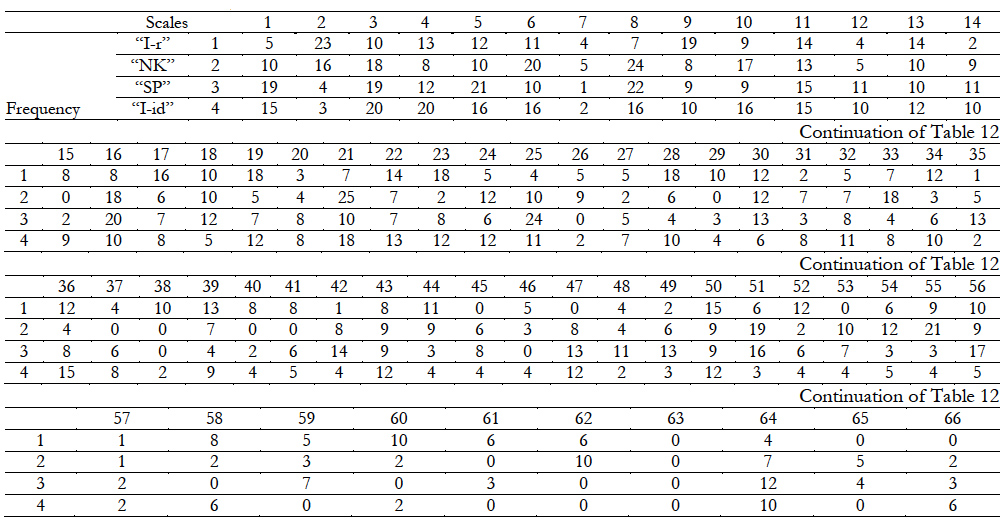
The SMSL equipment gives the chance to define a difference between these types "images I". Besides it can be used in other option of work when examinees do not make ranging, and estimate themselves on 66 scales in aspect of a self-assessment "I am-ideal" and "I am-real.". The specified characteristics have applied value for personal advisory and correctional work with respondents. Scale No. 59, 60, 61, 63, 65 is not enough or are not involved by respondents at all, that is they are not significant for them in respect of modeling and estimation "I am-ideal" (Table 13).
Summary results of factor analysis for all tasks are presented in Table 14.
These results of factor analysis show that to respondents of sample emphasis of attention in a self-assessment and assessment of self-realization on the following aspects is characteristic. It is the sphere of communication in which they are desired and significant, pleasant and loved, capable to realize the ideas. Also, it is emotional security and spontaneity of expression of emotions as qualities of the personality, trait of character, disposing to pleasure and satisfaction. Further, it is the strong-willed qualities of character defining self-confidence. Important aspect of estimation and orientations of respondents is the factor of "wellbeing in life".
Conclusion
The person, acting as the personality in society, "designs" the world, i.e. brings into the system of knowledge of the world. The conscious system organization of this information is under construction it by understanding of value of things and the ideas of the world and determination of their value and meaning of life in general that allows it to be the subject of life. It defines relevance of semantic approach in research MSO of the subject (7). Semantic standards of self-realization are integrated into "I am-concepts" of the personality and act as reference points of MSO of the subject. By means of the original SMSL equipment, semantic models of MSO of the personality were received and subject characteristics are defined. Comparative data of constructs of self-realization (in aspect "I am-ideal") and self-updating (SU) show that though SL and is reference (ideal) a model of achievements of the personality (according to A. Maslow, etc.), semantics of MSO of the subject reveals in orientations on near achievable aspects of prospect of life. Results of sample, along with the disclosed individual characteristics, showed statistical integrative features of subject MSO in orientations to semantic constructs of self-realization: emotional spontaneity and, at the same time, strength of mind and self-confidence and also communication and wellbeing in life (connected with intellectuality). These factors reflect functional specifics of semantics of motivation in MSO (emotional, strong-willed and intellectual parties) and also social aspect of the relations which are integrated in semantics of wellbeing of life. Obviously, it is connected with the fact that constructs of modeling open the social and role repertoire. However, in an expanded research it is revealed that the subject sphere also reflects the sociocultural nature of the organization of activity of the personality (Dyakov, 2016c).
The technique of "SMSL" can also be used in other options when examinees do not make ranging, and estimate themselves in aspect of a self-assessment "I am-ideal" and "I am-real" on all scales and model other types of the personality (friend, the beloved, etc.). A set of constructs of "SMSL" can be built on concrete sample.
Use of the SMSL equipment in a research nonverbal semantic MSO of the subject and also comparative characteristics reflecting to the MSO loudspeaker of the personality in different age stages and depending on specifics of professional, cultural and vital identification of the person is perspective (Dyakov, 2016c).














